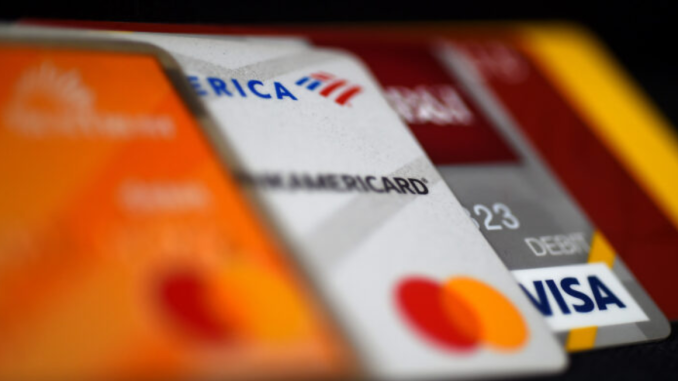
With the softening of the economy, consumers are starting to fall behind on their credit card and loan payments, with delinquency increasing modestly, according to executives at major U.S. banks.
Profits at Bank of America Corp, JPMorgan Chase, Wells Fargo, and Citigroup Inc. beat analyst forecasts as lending giants earned more revenue from clients’ interest payments on credit cards. However, industry chiefs don’t expect the good times to last as a recession looms and customer delinquencies climb.
“We’ve seen some consumer financial health trends gradually weakening from a year ago,” Wells Fargo Chief Financial Officer Mike Santomassimo said on a conference call Friday to discuss its first quarter results.
While delinquencies and net charge-offs—debt owed to a bank that is unlikely to be recovered—have slowly risen as expected, consumers and businesses generally remain strong, the bank’s CEO Charlie Scharf said.
Consumer Debt
During the early pandemic, credit card debt dipped 17 percent, Bankrate said—thanks partly to stimulus programs, emergency relief, and decreased consumer spending.
But in the last three months of 2022, credit card balances in the United States increased $61 billion to $986 billion, surpassing the pre-pandemic high of $927 billion, according to the Federal Reserve Bank of New York.
This puts credit card debt at the end of 2022 nearly 20 percent higher than it was at the end of 2021, according to the latest quarterly report by TransUnion.
Using a credit card can provide protection for people who can pay off the balance every month. But the cost for those who can’t is high.
“What’s not good is carrying balances, paying interest, and falling behind,” said Greg McBride, Bankrate analyst. “No one wants to be paying 20 percent every month.”
Inflation is another factor contributing to rising debt, McBride said, which means “the cost of day-to-day living is outpacing paychecks.”
Potential Loan Losses
Banks have tightened their lending standards and set aside more money to cover potential loan losses.
Wells Fargo set aside $1.2 billion in the first quarter to cover potential loan losses.
Bank of America provisioned $931 million for credit losses in the quarter, much higher than the $30 million a year prior but below the fourth quarter $1.1 billion provision.
JPMorgan more than doubled the amount it set aside for credit losses in the first quarter from a year earlier to $2.3 billion, reflecting net charge-offs of $1.1 billion.
Worsening economic conditions would lead to “credit deterioration throughout 2023 and 2024 with losses eventually surpassing pre-pandemic levels given an oncoming recession,” predicted UBS analysts led by Erika Najarian. Still, loan defaults are forecast to stay “below the peaks experienced in prior downturns,” they said.
Tightening Lending Standards
As large and medium-sized lenders become more conservative in underwriting, their net charge offs will probably peak in several quarters, wrote Morgan Stanley analyst Betsy Graseck. “This means slower loan growth” 2023 and 2024, she wrote.
The process is a delicate balance for lenders, who can hurt their bottom line if they tighten too much.
“It can almost be viewed as a high-wire act,” Gerard Cassidy, an analyst at RBC Capital Markets, told the Wall Street Journal. “On the one hand, you don’t want to be over conservative and shut down lending, but at the same time you don’t want your lending standards to fall by the wayside like in 2006.”
* Article From: The Epoch Times